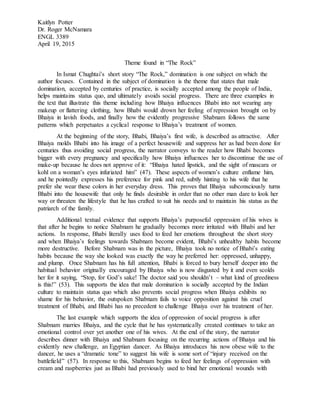
Short Paper 3
- 1. Kaitlyn Potter Dr. Roger McNamara ENGL 3389 April 19, 2015 Theme found in “The Rock” In Ismat Chughtai’s short story “The Rock,” domination is one subject on which the author focuses. Contained in the subject of domination is the theme that states that male domination, accepted by centuries of practice, is socially accepted among the people of India, helps maintains status quo, and ultimately avoids social progress. There are three examples in the text that illustrate this theme including how Bhaiya influences Bhabi into not wearing any makeup or flattering clothing, how Bhabi would drown her feeling of repression brought on by Bhaiya in lavish foods, and finally how the evidently progressive Shabnam follows the same patterns which perpetuates a cyclical response to Bhaiya’s treatment of women. At the beginning of the story, Bhabi, Bhaiya’s first wife, is described as attractive. After Bhaiya molds Bhabi into his image of a perfect housewife and suppress her as had been done for centuries thus avoiding social progress, the narrator conveys to the reader how Bhabi becomes bigger with every pregnancy and specifically how Bhaiya influences her to discontinue the use of make-up because he does not approve of it: “Bhaiya hated lipstick, and the sight of mascara or kohl on a woman’s eyes infuriated him” (47). These aspects of women’s culture enflame him, and he pointedly expresses his preference for pink and red, subtly hinting to his wife that he prefer she wear these colors in her everyday dress. This proves that Bhaiya subconsciously turns Bhabi into the housewife that only he finds desirable in order that no other man dare to look her way or threaten the lifestyle that he has crafted to suit his needs and to maintain his status as the patriarch of the family. Additional textual evidence that supports Bhaiya’s purposeful oppression of his wives is that after he begins to notice Shabnam he gradually becomes more irritated with Bhabi and her actions. In response, Bhabi literally uses food to feed her emotions throughout the short story and when Bhaiya’s feelings towards Shabnam become evident, Bhabi’s unhealthy habits become more destructive. Before Shabnam was in the picture, Bhaiya took no notice of Bhabi’s eating habits because the way she looked was exactly the way he preferred her: oppressed, unhappy, and plump. Once Shabnam has his full attention, Bhabi is forced to bury herself deeper into the habitual behavior originally encouraged by Bhaiya who is now disgusted by it and even scolds her for it saying, “Stop, for God’s sake! The doctor said you shouldn’t – what kind of greediness is this!” (53). This supports the idea that male domination is socially accepted by the Indian culture to maintain status quo which also prevents social progress when Bhaiya exhibits no shame for his behavior, the outspoken Shabnam fails to voice opposition against his cruel treatment of Bhabi, and Bhabi has no precedent to challenge Bhaiya over his treatment of her. The last example which supports the idea of oppression of social progress is after Shabnam marries Bhaiya, and the cycle that he has systematically created continues to take an emotional control over yet another one of his wives. At the end of the story, the narrator describes dinner with Bhaiya and Shabnam focusing on the recurring actions of Bhaiya and his evidently new challenge, an Egyptian dancer. As Bhaiya introduces his now obese wife to the dancer, he uses a “dramatic tone” to suggest his wife is some sort of “injury received on the battlefield” (57). In response to this, Shabnam begins to feed her feelings of oppression with cream and raspberries just as Bhabi had previously used to bind her emotional wounds with
- 2. Kaitlyn Potter Dr. Roger McNamara ENGL 3389 April 19, 2015 cream and fruit. Because no one at the table is in the social position to reprimand the unquestioned head of the family Bhaiya for his behavior; this further substantiates the claim that this “rock” is ultimately devastating to the spirits of previously independent-minded women. Readers can see repeated support for the theme that male domination, accepted by centuries of practice, is socially accepted among the people of India, in order to sustain the status quo for patriarchal oppression, and ultimately avoids social progress. Through Bhaiya’s purposeful actions, the text proves Bhaiya’s antiquated views are inexorably shaped by the patriarchy of the Indian culture. Work Cited Cughta, Ismat. “The Rock.” Trans. Tahira Naqvi. The Quilt & Other Stories. Riverdale-on Hudson: Sheep Meadow Press, 1994. 47-57. Print.